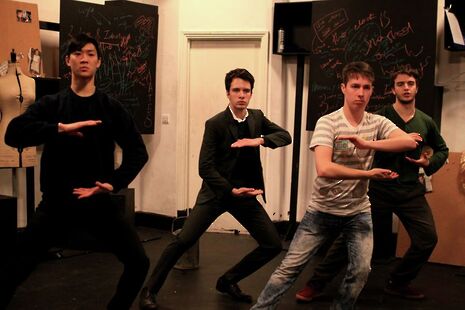Attempts on Her Life
Nicholas Ashurst is impressed, but not fully satisfied by this challenging play

Martin Crimp’s experimental play is always going to be hard to pull off. With no clear characters and no clear plot, his "seventeen scenarios for theatre" is a challenging and foreboding task. Tania Clarke’s production, however, manages to bring the script under control to create a polished and cohesive ensemble piece, full of energy and life.
While a lot of work clearly went into the design aspects of the production, the ensemble cast were the lifeblood of the piece. Intelligent casting meant that there was a diverse range of talent on display, moulded by Clarke into an organised unit. As a whole, they were highly effective, but the ensemble was also powerful on an individual level, as each actor brought something unique and different to the production. There were no weak links. They all maintained a high energy level throughout; although a special mention should go to the three actresses who held a plank position for about three minutes before continuing the scene with the same vigour afterwards.
Stylistically, the production was built on abstract movement and Brechtian style acting. Clarke’s interpretation of the text blended these stylistic aspects with comedy to create a visually lively piece. However, it seemed to remain on the same level throughout, and after the first few scenes failed to develop much further. By the halfway point it began to feel repetitive. This is not due to a lack of creative ideas, but more from a failure to take these ideas to a new level. There was a short, memorable moment in the middle which saw two of the actresses engage in an intimate movement sequence, at last opening up their humanity, but this was short-lived and failed to develop any further.
The general quality of the production was very high. The lighting and sound design was some of the best I’ve seen in Cambridge, and was clearly carefully considered to enhance the production. The set was functional and effective, allowing the actors to interact with it. The movement was highly polished and meticulously rehearsed. But despite this, I couldn’t help but feel that there was not much beneath the polish. A seeming lack of deeper engagement with the text meant I left feeling fairly hollow. One the one hand I admired the technical brilliance and collaborative process. On the other I wondered if it had perhaps lost something sacred along the way.
 News / SU reluctantly registers controversial women’s soc18 December 2025
News / SU reluctantly registers controversial women’s soc18 December 2025 News / CUP announces funding scheme for under-represented academics19 December 2025
News / CUP announces funding scheme for under-represented academics19 December 2025 Features / Should I stay or should I go? Cambridge students and alumni reflect on how their memories stay with them15 December 2025
Features / Should I stay or should I go? Cambridge students and alumni reflect on how their memories stay with them15 December 2025 Fashion / The art of the formal outfit 18 December 2025
Fashion / The art of the formal outfit 18 December 2025 Lifestyle / Summer lovin’ had me so… lonely?18 December 2025
Lifestyle / Summer lovin’ had me so… lonely?18 December 2025








